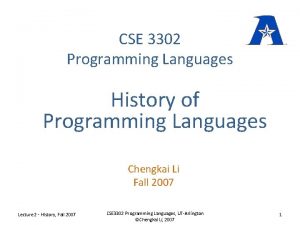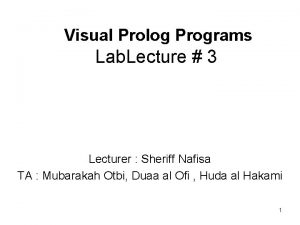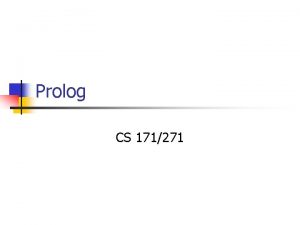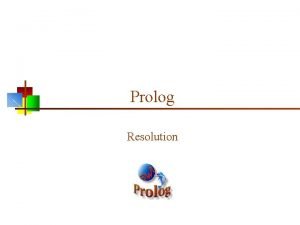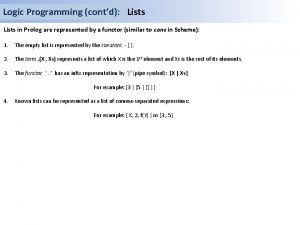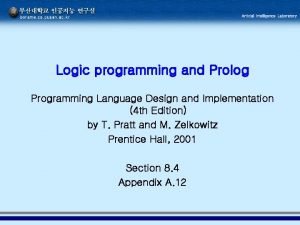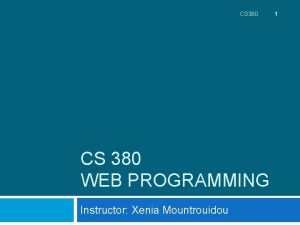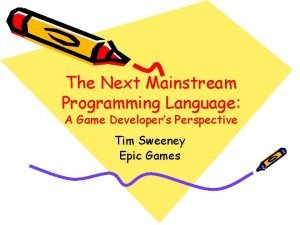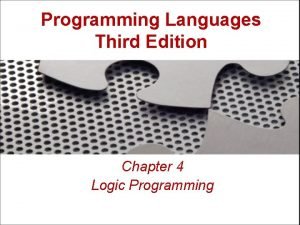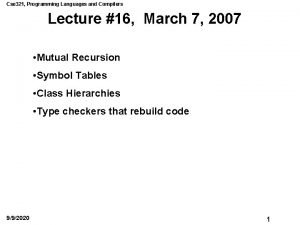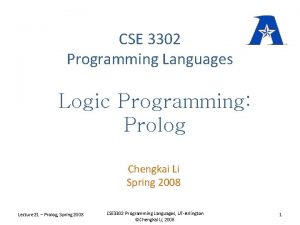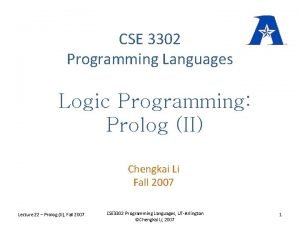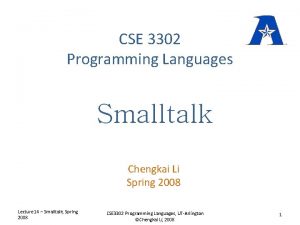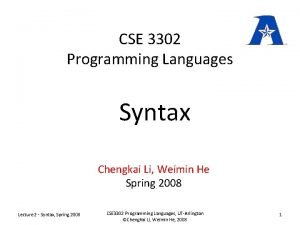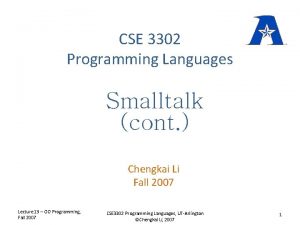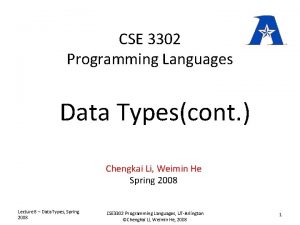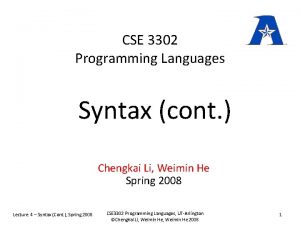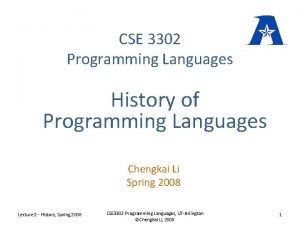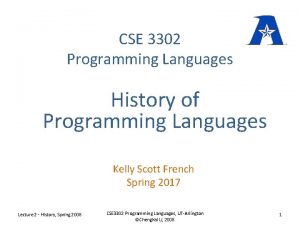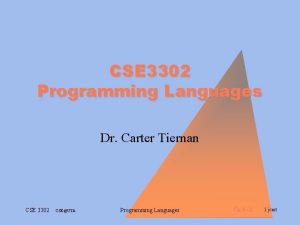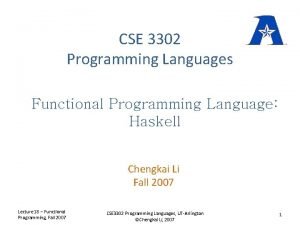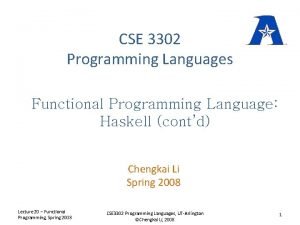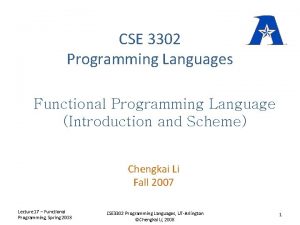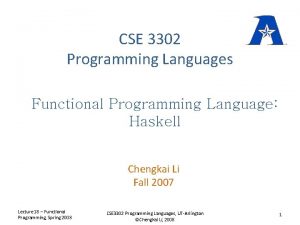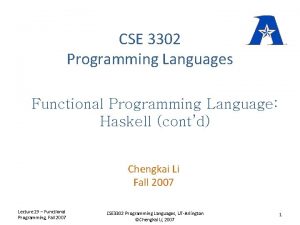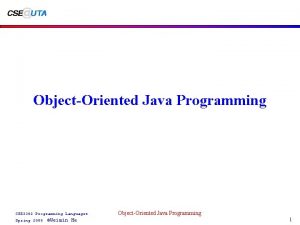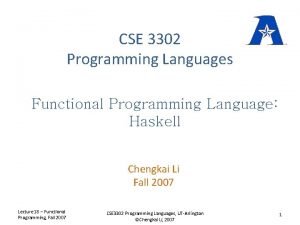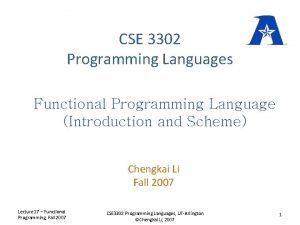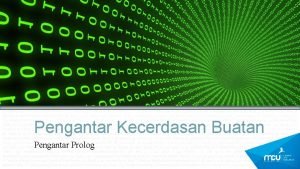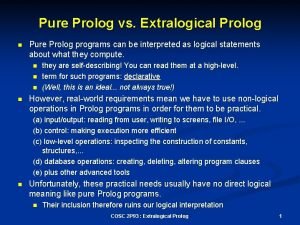CSE 3302 Programming Languages Logic Programming Prolog Chengkai

























- Slides: 25

CSE 3302 Programming Languages Logic Programming: Prolog Chengkai Li Fall 2007 Lecture 21 – Prolog, Fall 2007 CSE 3302 Programming Languages, UT-Arlington ©Chengkai Li, 2007 1

SWI-Prolog • http: //www. swi-prolog. org/ Lecture 21 – Prolog, Fall 2007 CSE 3302 Programming Languages, UT-Arlington ©Chengkai Li, 2007 2

Logic Programming • Program Axioms (facts): true statements • Input to Program query (goal): statement true (theorems) or false? • Logic programming systems = deductive databases datalog Lecture 21 – Prolog, Fall 2007 CSE 3302 Programming Languages, UT-Arlington ©Chengkai Li, 2007 3

Example • Axioms (facts): 0 is a natural number. For all x, if x is a natural number, then so is the successor of x. • Query (goal). 2 is natural number? -1 is a natural number? Lecture 21 – Prolog, Fall 2007 (can be proved by facts) (cannot be proved) CSE 3302 Programming Languages, UT-Arlington ©Chengkai Li, 2007 4

Another example • Facts: The factorial of 0 is 1. If m is the factorial of n - 1, then n * m is the factorial of n. • Query: The factorial of 2 is 3? (How do we ask “What is the factorial of 2? ”) Lecture 21 – Prolog, Fall 2007 CSE 3302 Programming Languages, UT-Arlington ©Chengkai Li, 2007 5

First-Order Predicate Calculus • Logic used in logic programming: First-order predicate calculus First-order predicate logic Predicate logic First-order logic x (x x+1) • Second-order logic S x (x S x S) Lecture 21 – Prolog, Fall 2007 CSE 3302 Programming Languages, UT-Arlington ©Chengkai Li, 2007 6

First-Order Predicate Calculus: Example • natural(0) X, natural(X) natural(successor(x)) • X and Y, parent(X, Y) ancestor(X, Y). A, B, and C, ancestor(A, B) and ancestor(B, C) ancestor(A, C). X and Y, mother(X, Y) parent(X, Y). X and Y, father(X, Y) parent(X, Y). father(Bill, Jill). mother(Jill, Sam). father(Bob, Sam). • factorial(0, 1). N and M, factorial(N-1, M) factorial(N, N*M). Lecture 21 – Prolog, Fall 2007 CSE 3302 Programming Languages, UT-Arlington ©Chengkai Li, 2007 7

First-Order Predicate Calculus: statements Symbols in statements: • Constants (a. k. a. atoms) numbers (e. g. , 0) or names (e. g. , Bill). • Predicates Names for Boolean functions (true/false). Can have arguments. (e. g. parent(X, Y)). • Functions non-Boolean functions (successor(X) ). • Variables e. g. , X. • Connectives (operations) and, or, not implication ( ): a b (b or not a) equivalence ( ) : a b (a b and b a) Lecture 21 – Prolog, Fall 2007 CSE 3302 Programming Languages, UT-Arlington ©Chengkai Li, 2007 8

First-Order Predicate Calculus: statements (cont’d) • Quantifiers universal quantifier "for all“ existential quantifier "there exists" bound variable (a variable introduced by a quantifier) free variable • Punctuation symbols parentheses (for changing associativity and precedence. ) comma period • Arguments to predicates and functions can only be terms: – Contain constants, variables, and functions. – Cannot have predicates, qualifiers, or connectives. Lecture 21 – Prolog, Fall 2007 CSE 3302 Programming Languages, UT-Arlington ©Chengkai Li, 2007 9

Horn Clause • First-order logic too complicated for an effective logic programming system. • Horn Clause: a fragment of first-order logic b a 1 and a 2 and a 3 … and an. head body no “or” and no quantifier b . fact b. query • Variables in head: universally quantified Variables in body only: existentially quantified • Need “or” in head? Multiple clauses Lecture 21 – Prolog, Fall 2007 CSE 3302 Programming Languages, UT-Arlington ©Chengkai Li, 2007 10

Horn Clauses: Example • First-Order Logic: natural(0). X, natural(X) natural(successor(x)). • Horn Clause: natural(0). natural(successor(x)) natural(X). Lecture 21 – Prolog, Fall 2007 CSE 3302 Programming Languages, UT-Arlington ©Chengkai Li, 2007 11

Horn Clauses: Example • First-Order Logic: factorial(0, 1). N and M, factorial(N-1, M) factorial(N, N*M). • Horn Clause: factorial(0, 1). factorial(N, N*M) factorial(N-1, M). Lecture 21 – Prolog, Fall 2007 CSE 3302 Programming Languages, UT-Arlington ©Chengkai Li, 2007 12

Horn Clauses: Example • Horn Clause: ancestor(X, Y) parent(X, Y). ancestor(A, C) ancestor(A, B) and ancestor(B, C). parent(X, Y) mother(X, Y). parent(X, Y) father(X, Y). father(Bill, Jill). mother(Jill, Sam). father(Bob, Sam). Lecture 21 – Prolog, Fall 2007 CSE 3302 Programming Languages, UT-Arlington ©Chengkai Li, 2007 13

Horn Clauses: Example • First-Order Logic: X, mammal(X) legs(X, 2) or legs(X, 4). • Horn Clause: legs(X, 4) mammal(X) and not legs(X, 2) mammal(X) and not legs(X, 4). Lecture 21 – Prolog, Fall 2007 CSE 3302 Programming Languages, UT-Arlington ©Chengkai Li, 2007 14

Prolog syntax • : - for , for and ancestor(X, Y) : - parent(X, Y). ancestor(X, Y) : - ancestor(X, Z), ancestor(Z, Y). parent(X, Y) : - mother(X, Y). parent(X, Y) : - father(X, Y). father(bill, jill). mother(jill, sam). father(bob, sam). Lecture 21 – Prolog, Fall 2007 CSE 3302 Programming Languages, UT-Arlington ©Chengkai Li, 2007 15

Problem Solving • • Program = Data + Algorithms Program = Object. Message(Object) Program = Functions Algorithm = Logic + Control Programmers: facts/axioms/statements Logic programming systems: prove goals from facts • The holy grail: we specify the logic itself, the system proves. – Not totally realized by logic programming languages. Programmers must be aware of how the system proves, in order to write efficient, or even correct programs. • Prove goals from facts: – Resolution and Unification Lecture 21 – Prolog, Fall 2007 CSE 3302 Programming Languages, UT-Arlington ©Chengkai Li, 2007 16

Resolution • Resolution: Using a clause, replace its head in the second clause by its body, if they “match”. • a a 1, …, an. b b 1, …, bi, …, bm. if bi matches a; b b 1, …, an, …, bm. Lecture 21 – Prolog, Fall 2007 CSE 3302 Programming Languages, UT-Arlington ©Chengkai Li, 2007 17

Resolution: Another view • Resolution: Combine two clauses, and cancel matching statements on both sides. • a a 1, …, an. b b 1, …, bi, …, bm. a, b a 1, …, an, b 1, …, bi, …, bm. Lecture 21 – Prolog, Fall 2007 CSE 3302 Programming Languages, UT-Arlington ©Chengkai Li, 2007 18

Problem solving in logic programming systems • Program: – Statements/Facts (clauses). • Goals: – Headless clauses, with a list of subgoals. • Problem solving by resolution: – Matching subgoals with the heads in the facts, and replacing the subgoals by the corresponding bodies. – Cancelling matching statements. – Recursively do this, till we eliminate all goals. (Thus original goals proved. ) Lecture 21 – Prolog, Fall 2007 CSE 3302 Programming Languages, UT-Arlington ©Chengkai Li, 2007 19

Example • Fact: mammal(human). • Goal: mammal(human). • Proving: mammal(human). . Lecture 21 – Prolog, Fall 2007 CSE 3302 Programming Languages, UT-Arlington ©Chengkai Li, 2007 20

Example • Fact: legs(X, 2) mammal(X), arms(X, 2). legs(X, 4) mammal(X), arms(X, 0). mammal(horse). arms(horse, 0). • Goal: legs(horse, 4). • Proving: ? Lecture 21 – Prolog, Fall 2007 CSE 3302 Programming Languages, UT-Arlington ©Chengkai Li, 2007 21

Unification • Unification: Pattern matching to make statements identical (when there are variables). • Set variables equal to patterns: instantiated. • In previous example: legs(X, 4) and legs(horse, 4) are unified. (X is instantiated with horse. ) Lecture 21 – Prolog, Fall 2007 CSE 3302 Programming Languages, UT-Arlington ©Chengkai Li, 2007 22

Unification: Example • Euclid’s algorithm for greatest common divisor • Facts: gcd(U, 0, U). gcd(U, V, W) not zero(V), gcd(V, U mod V, W). • Goals: gcd(15, 10, X). Lecture 21 – Prolog, Fall 2007 CSE 3302 Programming Languages, UT-Arlington ©Chengkai Li, 2007 23

Things unspecified • The order to resolve subgoals. • The order to use clauses to resolve subgoals. • Possible to implement systems that don’t depend on the order, but too inefficient. • Thus programmers must know the orders used by the language implementations. (Search Strategies) Lecture 21 – Prolog, Fall 2007 CSE 3302 Programming Languages, UT-Arlington ©Chengkai Li, 2007 24

Example • Facts: ancestor(X, Y) : - ancestor(X, Z), parent(Z, Y). ancestor(X, Y) : - parent(X, Y) : - mother(X, Y). parent(X, Y) : - father(X, Y). father(bill, jill). mother(jill, sam). father(bob, sam). • Queries: ? - ancestor(bill, sam). ? - ancestor(X, bob). Lecture 21 – Prolog, Fall 2007 CSE 3302 Programming Languages, UT-Arlington ©Chengkai Li, 2007 25
 Cse 3302
Cse 3302 Cryptarithmetic problem logic+logic=prolog
Cryptarithmetic problem logic+logic=prolog Cse 340 principles of programming languages
Cse 340 principles of programming languages Vineeth kashyap
Vineeth kashyap Visual prolog vs swi-prolog
Visual prolog vs swi-prolog Visual prolog vs swi-prolog
Visual prolog vs swi-prolog Proposition examples sentences
Proposition examples sentences Prolog programming
Prolog programming Prolog design
Prolog design Real-time systems and programming languages
Real-time systems and programming languages Cs 421 programming languages and compilers
Cs 421 programming languages and compilers Multithreading program in java
Multithreading program in java Programming languages levels
Programming languages levels Introduction to programming languages
Introduction to programming languages Plc programming languages
Plc programming languages Joey paquet
Joey paquet Comparative programming languages
Comparative programming languages Alternative programming languages
Alternative programming languages Strongly typed vs weakly typed
Strongly typed vs weakly typed Transmission programming languages
Transmission programming languages Int vs short
Int vs short Xenia programming languages
Xenia programming languages Advantages of application software
Advantages of application software Mainstream programming languages
Mainstream programming languages Programing languages
Programing languages Programming languages
Programming languages
